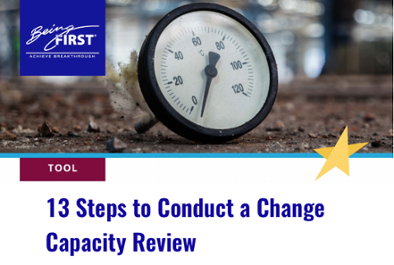For years, we have been tracking the Common Mistakes being made by leaders in how they lead change, especially transformational change. In each of our clients, we do a simple audit of these Common Mistakes to help them see which mistakes they are either making, or are prone to make as they proceed. The most common mistake we currently see in clients is not managing capacity for change.
Capacity can be defined as the organization’s total workload the leaders and workforce can deliver. Capacity has to be shared between running current operations and conducting change activities.
If your organization does not have the change capacity to add more workload, then launching yet another change effort is doomed for failure right from the start.

Change consumes resources, time, and attention, and no matter what you do, change efforts impact operations because they consume change capacity that would otherwise have been devoted to operations. The key is to manage this impact so your change efforts have the least negative impact on operations possible. If your organization is running at 100% capacity, then you will need to create capacity for change to be successful. Read on to learn how to do that.
Some executives seem to carry an unconscious belief that their workforce is not working as hard as it could. In our observation, this is seldom the case. It is often the case, however, that operations can be improved, made more efficient and streamlined. This will of course free up some capacity. But remember, it takes capacity to deliver these improvements.
It is most useful, we find, to assume that your organization is running at full capacity, and that you will need to free up capacity to deliver optimal results from your change efforts. This assumption will cause you to look more deeply into just how you might do that, and that will lead to insight and good decisions about managing capacity.
The Benefits of Attending to Capacity for Change
Addressing capacity has many positive benefits. First and foremost, it sets up your change efforts for success by ensuring that realistic and adequate time, resources, and skills are directly devoted to your transformation.
Addressing capacity also generates critical leadership credibility, as employees see that leaders are being realistic and are not just “living in the ivory tower.” It engenders key employee trust at a time when it is most needed – while you undergo change. Good capacity management lowers the cost to both operations and morale.
Managing capacity well unlocks people’s energy and spirit because they feel more certain that the change can actually succeed. When staff feels burdened by yet another change effort “dumped on them” without any capacity management, they feel victimized, not empowered for success. Overtly managing capacity builds social capital that you can cash in a later date when you really need people to go the extra mile.
You will be amazed at the positive reaction you will get when you announce that you have stopped a piece of work to devote its capacity to another, higher priority project. This overtly delivers the message about what projects are most important, and that employees themselves carry high importance.
How to Free Up Capacity for Change
This is where the rubber hits the road. You can talk about capacity until the cows come home, but if you don’t actually free up capacity to devote to your change effort, you’ll be doomed for failure.
The key is to do a capacity audit. This can be a formal assessment with lots of rigor, or it can be informal and done rather quickly. Often, just by gathering the right people in a room to address capacity, and talking about the challenges, will reveal a number of ways to gain more capacity. Key is to take a large systems view and consider strategic priorities. If you don’t have priorities clear, then you’ll need to start there.
Once you have a sense of how much change capacity you’ll need to free up, consider these options.
- Stop some work. Yes, actually take it off the plate. We know this can be a really tough decision, and will require some collective thought and decision-making among your leaders. They may not like it, but it IS their job to make these strategic decisions, and if a successful change effort is a strategic priority, then making tough capacity decisions are a must.
- Adjust timelines. Decide what work you can slow down. In some organizations, schedule is king, and once a schedule is made, it is often difficult to get it adjusted. But that difficulty is not a reason to set up critical change efforts for failure by launching them without the capacity to make them successful.
- Pause some work. Put it on the back burner. Delay it indefinitely until the time is right to start it back up.
- Reallocate existing people with the best skills to your priority change efforts. Put your superstars where they belong – on your most important projects. For this strategy to work well, you will have to have a solid succession plan with talent ready to fill the voids.
- Hire people with the right skills and knowledge. This increases cost for the sake of speed. This trade-off is a critical decision for leaders to address. The extra cost will be much better than losing your best talent because you keep burning them out.
- Outsource work, and use external experts to do some of the critical work you do not want to stop or delay.
Major organizational change is not something that happens in a bubble – both leaders and employees must have bandwidth on top of their daily tasks if any of these initiatives are going to have a solid chance at success. Prepare your employees for the change in advance by addressing your organization’s capacity for change. Then it won’t be such a shock to their psyches or workload once the change gets moving, and you will find them far more committed to making it a success.


